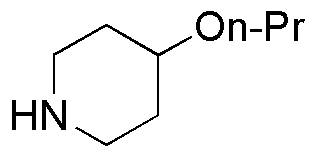4-Propoxy-piperidine is widely utilized in research focused on:
- Pharmaceutical Development: This compound serves as a key intermediate in synthesizing various pharmaceuticals, particularly in creating analgesics and anti-inflammatory drugs.
- Neuroscience Research: It is used in studies investigating neurotransmitter systems, helping researchers understand brain functions and develop treatments for neurological disorders.
- Organic Synthesis: The compound acts as a versatile building block in organic chemistry, enabling the creation of complex molecules for various applications in chemical manufacturing.
- Agrochemical Formulations: 4-Propoxy-piperidine is incorporated into formulations for pesticides and herbicides, enhancing their effectiveness and stability in agricultural applications.
- Material Science: Its properties make it useful in developing polymers and coatings, providing improved durability and resistance in various industrial applications.
General Information
Properties
Safety and Regulations
Applications
4-Propoxy-piperidine is widely utilized in research focused on:
- Pharmaceutical Development: This compound serves as a key intermediate in synthesizing various pharmaceuticals, particularly in creating analgesics and anti-inflammatory drugs.
- Neuroscience Research: It is used in studies investigating neurotransmitter systems, helping researchers understand brain functions and develop treatments for neurological disorders.
- Organic Synthesis: The compound acts as a versatile building block in organic chemistry, enabling the creation of complex molecules for various applications in chemical manufacturing.
- Agrochemical Formulations: 4-Propoxy-piperidine is incorporated into formulations for pesticides and herbicides, enhancing their effectiveness and stability in agricultural applications.
- Material Science: Its properties make it useful in developing polymers and coatings, providing improved durability and resistance in various industrial applications.
Documents
Safety Data Sheets (SDS)
The SDS provides comprehensive safety information on handling, storage, and disposal of the product.
Product Specification (PS)
The PS provides a comprehensive breakdown of the product’s properties, including chemical composition, physical state, purity, and storage requirements. It also details acceptable quality ranges and the product's intended applications.
Certificates of Analysis (COA)
Search for Certificates of Analysis (COA) by entering the products Lot Number. Lot and Batch Numbers can be found on a product’s label following the words ‘Lot’ or ‘Batch’.
*Catalog Number
*Lot Number
Certificates Of Origin (COO)
This COO confirms the country where the product was manufactured, and also details the materials and components used in it and whether it is derived from natural, synthetic, or other specific sources. This certificate may be required for customs, trade, and regulatory compliance.
*Catalog Number
*Lot Number
Safety Data Sheets (SDS)
The SDS provides comprehensive safety information on handling, storage, and disposal of the product.
DownloadProduct Specification (PS)
The PS provides a comprehensive breakdown of the product’s properties, including chemical composition, physical state, purity, and storage requirements. It also details acceptable quality ranges and the product's intended applications.
DownloadCertificates of Analysis (COA)
Search for Certificates of Analysis (COA) by entering the products Lot Number. Lot and Batch Numbers can be found on a product’s label following the words ‘Lot’ or ‘Batch’.
*Catalog Number
*Lot Number
Certificates Of Origin (COO)
This COO confirms the country where the product was manufactured, and also details the materials and components used in it and whether it is derived from natural, synthetic, or other specific sources. This certificate may be required for customs, trade, and regulatory compliance.


